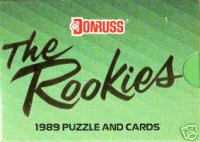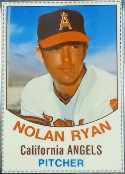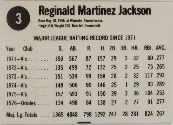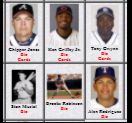1989 Donruss THE ROOKIES - FACTORY SET (56 cards, mostly Rookies)
Includes ROOKIE CARDS of Ken Griffey Jr,Gary Sheffield,Randy Johnson,Omar Vizquel,Deion Sanders,Steve Finley,Kenny Rogers & MORE !!!

Please wander around the website for more info, prices, values & images
on vintage baseball, football, basketball, hockey, sport and non-sports cards.
Magic Johnson basketball cards
|



1977 Hostess 'Twinkies' Baseball
Following their 1975 and 1976 issues, Hostess again issued special,
scarcer versions of their cards only found on selected boxes like
Twinkies and Cupcakes.
They have same fronts as regular 1977 Hostess but slightly
different backs and identified by the black bar that can usually be
seen on the back of the card. They were originally (1975/1976) issued
with Twinkies thus they are now called "Twinkies" versions.
Click for complete
1977 Hostess Twinkies Baseball Checklist, Values & Info
The cards issued on Cupcake boxes had very tiny print on the back and are often referred to as "Small Print". Note: A few cards were issued in both variations. Note: You may be on that page right now. Click for complete 1977 Hostess Baseball Checklist, Values & Info |

High Numbers - vintage cards were issued in the ‘50s-‘70s in a series. During the baseball season, the largest number of cards were made. As the schedule progressed into September, when there would be less interest in baseball cards , Topps for one, specifically decreased production and hence much less product was available. As a result, a scarcity-factor was created and a premium holds for these first type of "short-printed" cards.
Inserts - special randomly-inserted cards which are not part of the regular set. Many modern inserts are sequentially-numbered and rarer than the card sets into which they are inserted.
O-Pee-Chee / OPC - a subsidiary of Topps, this card issue was produced specifically for distribution in Canada.
Promotional Card - generally referred to as cards issued to show what the product will look like on release and intended to help spur future sales. Often called a "promo" card.
Reprint - cards issued to reproduce the originals. With the current trend of vintage reprints, the new versions have a distinguishing characteristic evidenced by numbering.
Restored - a card or piece of memorabilia which someone has tried to return to a "like-new" condition. A restored card is considered to be of very little value.
Rookie Card - any league-licensed, widely distributed card to feature a player in his first year of trading cards.
 Click here to view other players
Click here to view other players
